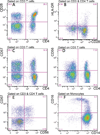Association of Elevations of Specific T Cell and Monocyte Subpopulations in Rheumatoid Arthritis With Subclinical Coronary Artery Atherosclerosis
- PMID: 26360530
- PMCID: PMC4690807
- DOI: 10.1002/art.39419
Association of Elevations of Specific T Cell and Monocyte Subpopulations in Rheumatoid Arthritis With Subclinical Coronary Artery Atherosclerosis
Abstract
Objective: Coronary artery disease (CAD) is the leading cause of excess deaths in rheumatoid arthritis (RA). However, identification of features denoting patients with a risk of developing CAD is lacking. The composition of circulating peripheral blood mononuclear cell (PBMC) subsets in RA patients differs markedly from that in healthy controls with regard to the extent of T cell activation, with clonal expansion and differentiation to effector memory status, and presence of inflammatory monocytes. In this study, we sought to evaluate whether elevations in these PBMC subpopulations in RA patients could denote those with an increased risk of subclinical CAD, as determined by the presence of coronary artery calcification (CAC).
Methods: The study cohort comprised 72 patients with RA who underwent cardiac computed tomography to assess CAC. PBMC subsets were determined by multiparameter flow cytometry. Multivariable logistic regression was used to determine the associations between PBMC subpopulations and the presence of CAC.
Results: Among the 72 patients with RA, 33% had CAC and exhibited significant increases in the levels of circulating CD4 T cell subsets denoting activation and differentiation to the effector memory phenotypes. Analogous increases in the levels of CD8 T cell subsets, as well as in the CD14(high)CD16+ intermediate monocyte subset, were also present in these patients, as compared to those without CAC. The increases in the CD4 and CD8 T cell subsets were highly intercorrelated, whereas the increases in CD14(high)CD16+ monocytes were independent of elevations in the CD4 T cell subsets. After adjustments for relevant confounders, the levels of CD4+CD56+CD57+ T cells and CD14(high)CD16+ monocytes remained associated with the presence of CAC.
Conclusion: These findings indicate that PBMC subsets are markers for the presence of CAC and suggest that mechanisms of atherogenesis in RA may operate in part through the elevations in these subsets, raising further questions about the mechanisms underlying the presence of such alterations in cell composition in patients with RA and the potential for shared etiologic pathways between RA and cardiovascular disease.
© 2015, American College of Rheumatology.
Conflict of interest statement
This study has not had any financial support or other benefits from commercial sources for the work and all of the authors declare they have no potential or real conflicts of interest.
Figures


References
-
- del Rincon ID, Williams K, Stern MP, Freeman GL, Escalante A. High incidence of cardiovascular events in a rheumatoid arthritis cohort not explained by traditional cardiac risk factors. Arthritis Rheum. 2001;44:2737–2745. - PubMed
-
- Wolfe F, Mitchell DM, Sibley JT, Fries JF, Bloch DA, Williams CA, Spitz PW, Haga M, Kleinheksel SM, Cathey MA. The mortality of rheumatoid arthritis. Arthritis Rheum. 1994;37:481–494. - PubMed
-
- Gregersen P, Silver J, Winchester R. The shared epitope hypothesis: An approach to understanding the molecular genetics of susceptibility to rheumatoid arthritis. Arthritis Rheum. 1987;30:1205–1213. - PubMed
Publication types
MeSH terms
Substances
Grants and funding
LinkOut - more resources
Full Text Sources
Other Literature Sources
Medical
Research Materials
Miscellaneous

